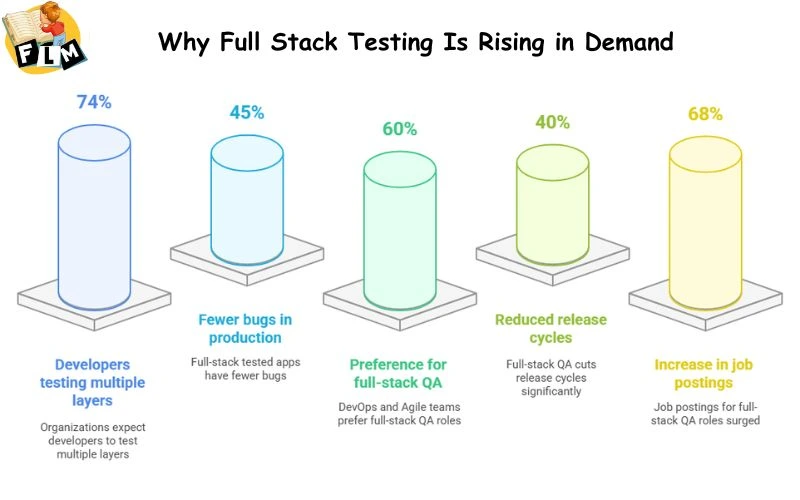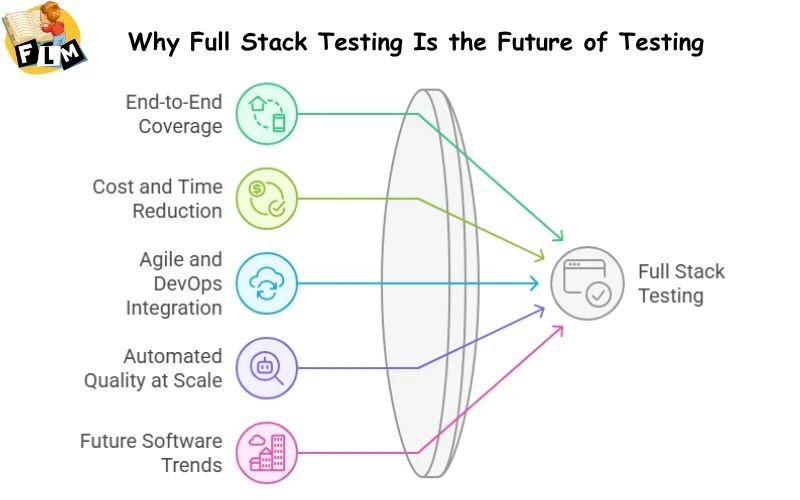The world of software is changing rapidly, and so are the testing methods. No longer is testing simply concerned with isolated components of an application. Software today is a sophisticated ecosystem of frontends, backends, APIs, and databases all collaborating with each other. And it’s because of this that businesses are moving towards an end-to-end approach: Full Stack Testing. In this blog post, we’ll break down simply why full-stack testing is going to be the future of software testing. You’ll get what it’s about, why you need it, and how it’s transforming the QA scenario.
What Is Full Stack Testing?
Full stack testing refers to testing an application from bottom to top, from user interfaces (UI) to APIs, databases, servers, and integrations. It makes sure that the whole software stack works flawlessly across all layers.
In simple words, it’s like inspecting an entire home, not the walls or windows alone, but the entire foundation to roof, plumbing, and electricity.
Dreaming of a High-Paying career in tech?
Start learning online with Frontlines Edutech where Java, Python, Testing, and more are made simple and beginner-friendly!
Begin your journey today and turn your dreams into success.
Why Full Stack Testing Is Rising in Demand

Let’s consider the figures that attest to the fact that full-stack testing is the future of testing:
- 74% of organizations now expect developers to test multiple layers, rather than UI or backend. (Source: World Quality Report 2024)
- Full-stack tested applications have 45% fewer bugs in prod.
- 60% of DevOps and Agile teams prefer full-stack QA job roles compared to siloed testers.
- Organizations that adopted full-stack QA practices cut release cycles by 40%.
- Job postings with “Full Stack QA” or “SDET” positions have increased by 68% over the past two years. (Source: Naukri & LinkedIn)
These statistics indicate a distinct change in the manner in which businesses desire software to be tested. End-to-end quality coverage is the future of testing.
How Full Stack Testing Supports Modern Software Practices
Agile & DevOps Ready
Agile teams operate in brief cycles, anticipating quick feedback and faster releases. Full stack testing is well-suited here by:
- Early catching of bugs in all layers
- Facilitating continuous integration (CI) and delivery (CD)
- Enabling testers to cooperate with devs better.
Supports Shift Left & Automation
The “shift-left testing” idea is referring to testing early in the development process. Full stack testers create test cases for:
- Frontend behavior
- Backend logic
- APIs
- Database validations
They also develop automated pipelines for executing these tests with each change in code.
Key Benefits of Full Stack Testing for the Future
End-to-End Quality Assurance
Full stack testing provides end-to-end visibility from user interactions to system responses. This facilitates the identification of:
- Broken APIs
- Data flow inconsistencies
- UI problems
- Server errors
This end-to-end approach makes it perfect for the future of testing.
Improved Automation Coverage
Automation tools of today (such as Cypress, Selenium, Playwright, Postman) enable full stack testers to automate UI, API, and performance tests saving huge time during releases.
Early Bug Detection = Cost Saving
Studies indicate that it costs 6x more to repair a bug in production than in development. Full stack testing catches them early throughout the stack.
Faster Delivery
With continuous testing pipelines and full stack coverage, developers ship stable builds quicker a core requirement in today’s software delivery model.
Tools Used in Full Stack Testing
Here’s a breakdown of essential tools for each layer:
| Layer | Common Tools |
| FrontEnd | Selenium, Cypress, Playwright |
| API | Postman, REST Assured, Swagger |
| BackEnd | JUnit, Mocha, TestNG |
| Database | SQL, MongoDB, DbFit |
| CI/CD | Jenkins, GitHub Actions, CircleCI |
| Performance | JMeter, Locust |
A full-stack QA engineer may use 3–5 tools together in real-world test suites.
Real-World Examples: Companies Using Full Stack Testing
Top Indian IT Companies
- TCS has launched full-stack testing positions in its QA department.
- Infosys promotes automation testers to perform both UI and API testing.
- Wipro upskills freshers in full-stack QA through in-house upskilling initiatives.
Global Product Companies
- Google and Meta employ SDETs who work across the entire tech stack.
- Netflix integrates backend, frontend, and microservices testing into a single automation flow.
- Spotify incorporates full-stack testing into its DevOps pipelines.
This growing adoption shows why full-stack testing is driving the future of testing.
Skills You Need to Become a Full Stack Tester
Technical Skills
- Basic frontend proficiency: HTML, CSS, JavaScript
- API test skills: REST, Postman
- Automation technologies: Selenium/Cypress for UI, REST Assured for APIs
- Basic programming backend: Java or Python
- SQL and query database skills
QA Skills
- Manual Testing
- Knowledge of Agile/Scrum
- Writing of test cases and bug tracking
- CI/CD tools (Git, Jenkins)
These steps may even be mastered by non-IT graduates and develop into full-stack testers, one of the most sought-after roles in future testing.
Career Growth and Salary Trends
Here’s why becoming a full-stack tester is a smart move:
Job Titles
- Full Stack QA Engineer
- SDET (Software Development Engineer in Test)
- Test Automation Engineer
- DevTestOps Engineer
Salary Trends in India (2025)
| Experience | Avg Salary (INR) |
| Fresher(0-2 Yrs) | 4-6 LPA |
| Mid-Level (3-5 Yrs) | 8-12 LPA |
| Expert (5+ Yrs) | 15-20 LPA (SDET Lead) |
Why Full Stack Testing Is the Future of Testing

In summary, here’s why this testing technique is becoming the foundation of future QA:
- Provides end-to-end coverage across all app layers
- Reduces cost, time, and risk in releases
- Integrates into Agile and DevOps pipelines
- Drives automated quality at scale
- Readies QA teams for future software trends such as AI, microservices, and cloud
In short, if you’re looking for a future-proof career, learning full-stack testing is the correct choice, because it is the future of testing.
Final Thoughts
If you are a beginner or a manual tester who wants to expand, the time is right to upskill. The future of testing is automation, velocity, and end-to-end quality. And full-stack testing is at the center of it.
We at Frontlines Edutech assist Telugu speaking students and working professionals in switching to IT careers with real-time hands-on experience in Full Stack Testing, DevOps, and others. Our industry-ready curriculum is designed for future QA careers.
Suggested Articles:
-
Manual vs Automation vs Full Stack Testing – What Should You Learn?
-
What Is Full Stack Testing? A Beginner-Friendly Guide
-
Is Full Stack Testing a Good Career Option in 2025?
Launch Your Career with Frontlines Edutech’s Full Stack Testing Online Course
Why Join?
- No coding needed – beginner-friendly
- In-demand QA skills with ₹5–12 LPA salary potential
- Complete testing journey in one course
Course Starts: 2nd June 2025
Timings: 8:00 PM – 9:00 PM (Live Daily)
Duration: 4 Months | Language: Simple Telugu
What You’ll Learn:
- Manual Testing + Agile + SQL
- API Testing with Postman
- Selenium Automation with Java
- DevOps: Git, Jenkins & CI/CD
This Course Includes:
- 10+ Real-Time Projects
- Resume & Interview Support
- Daily Assignments & Downloadable Notes
- Course Completion Certificate
Unlock your future with FLM’s Full Stack Testing Course
Limited Seats Only – Enroll Now!
Visit: frontlinesedutech.com | Click Here to Enroll
WhatsApp: 8333077727

